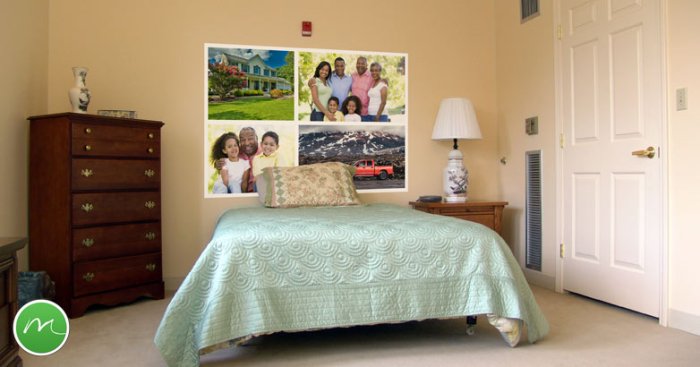How do you decorate an Alzheimers room? Tips and ideas for creating a comforting space
Understanding Alzheimer’s Disease
How do you decorate an alzheimer’s room – Alzheimer’s disease is a progressive neurological disorder that affects memory, thinking, and behavior. It is the most common cause of dementia among older adults, with symptoms typically starting to appear in individuals over the age of 65. As the disease progresses, it can have a significant impact on a person’s ability to function independently and may lead to changes in personality and behavior.
Importance of Environment in Alzheimer’s Care
Creating a supportive and stimulating environment is crucial for individuals with Alzheimer’s disease. The physical surroundings can have a significant impact on their comfort, safety, and overall well-being. A well-designed environment can help reduce confusion and agitation, promote independence, and enhance quality of life.
When looking to spruce up your living space, one of the first things to consider is how can decorate my room. By adding some personal touches like artwork, throw pillows, or a new rug, you can instantly transform the look and feel of your room. To get some inspiration and ideas, check out this helpful guide on how can decorate my room.
Tips for Decorating an Alzheimer’s Room
1. Use familiar and meaningful items: Incorporate objects that hold sentimental value or trigger positive memories for the individual.
2. Create a calming atmosphere: Choose soft, soothing colors and avoid clutter to reduce stress and anxiety.
3. Ensure safety and accessibility: Remove tripping hazards, install grab bars, and make sure furniture is arranged to promote easy navigation.
4. Provide sensory stimulation: Include tactile objects, music, and aromatherapy to engage the senses and promote cognitive function.
What is Known About Alzheimer’s Room Decor

Research has shown that the physical environment can have a significant impact on individuals with Alzheimer’s disease. A study published in the Journal of Alzheimer’s Disease found that a well-designed environment can improve mood, behavior, and cognitive function in individuals with dementia.
Solution for Decorating an Alzheimer’s Room

By incorporating the tips mentioned above and taking into account the individual’s preferences and needs, you can create a personalized and therapeutic environment that promotes a sense of familiarity, security, and well-being for individuals with Alzheimer’s disease.
Detailed Information on Decorating an Alzheimer’s Room
When decorating an Alzheimer’s room, it is important to consider the individual’s stage of the disease, personal preferences, and sensory needs. For example, individuals in the early stages of Alzheimer’s may benefit from a room that is well-organized and minimally decorated, while those in later stages may require more sensory stimulation and familiar objects to help trigger memories and emotions.
Describing in Depth the Decorative Elements: How Do You Decorate An Alzheimer’s Room
Decorative elements such as photographs, artwork, and familiar objects can help create a sense of continuity and connection to the past for individuals with Alzheimer’s disease. It is important to choose items that are meaningful and relevant to the individual’s life experiences, hobbies, and interests.
Conclusion
Decorating an Alzheimer’s room requires careful consideration of the individual’s needs, preferences, and stage of the disease. By creating a personalized and therapeutic environment, you can help improve the quality of life for individuals with Alzheimer’s disease and enhance their overall well-being.
FAQs
1. How can sensory stimulation benefit individuals with Alzheimer’s disease?
When it comes to decorating your room, there are many creative ideas you can explore to make it more personalized and appealing. From choosing the right color scheme to selecting furniture and decor pieces that reflect your style, the possibilities are endless. You can get inspiration from various sources, such as interior design websites and magazines. For more tips on how to decorate your room effectively, check out this helpful guide on how can decorate my room.
Sensory stimulation can help engage the senses, promote cognitive function, and reduce agitation in individuals with Alzheimer’s disease.
2. What colors are recommended for creating a calming atmosphere in an Alzheimer’s room?
Soft, soothing colors such as blues, greens, and earth tones are often recommended for individuals with Alzheimer’s disease.
3. How can familiar objects help individuals with Alzheimer’s disease?
Familiar objects can trigger positive memories, emotions, and associations, helping individuals with Alzheimer’s disease feel more connected and secure.
4. What safety measures should be taken when decorating an Alzheimer’s room?
Removing tripping hazards, installing grab bars, and ensuring furniture is arranged for easy navigation are important safety measures to consider.
5. How can music and aromatherapy be used to provide sensory stimulation in an Alzheimer’s room?
Music and aromatherapy can help engage the senses, evoke memories, and promote relaxation and well-being in individuals with Alzheimer’s disease.



